|
Displaying items by tag: contemporary
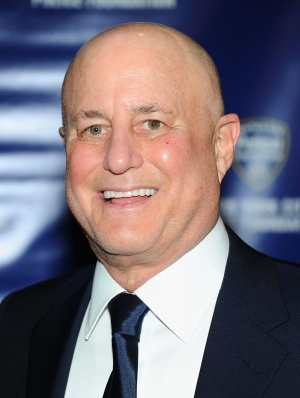
Ronald Perelman and Gagosian Gallery Inc. sued each other over payment for the billionaire’s purchases of contemporary art.
Perelman twice failed to pay an agreed-upon price after delivery of a sculpture and a painting and refused to meet a payment schedule for an unfinished sculpture, according to a lawsuit filed today by the New York-based gallery in New York State Supreme Court in Manhattan.
Perelman, 69, also filed suit against the gallery and its owner, Larry Gagosian, in the same courthouse today, accusing them of concealing material information and using their position in the art world to manipulate the price of artwork.
Gagosian “raced to the courthouse with his suit in a failed attempt to take the focus off the lawsuit we filed today accusing him of fraud, breach of duty and breach of contract,” Christine Taylor, a spokeswoman for Perelman, said in a statement. “Gagosian has used his dominance of the market for contemporary art to enrich himself at the expense of his customers. His complaint is frivolous -- the works he identifies are fully paid for, and we will seek redress for this improper filing at the appropriate time.”
Picasso’s lovers, Richard Serra's steel and Andreas Gursky’s yacht-studded Monaco are the highlights of a $130 million trove Gagosian Gallery is taking for its first expedition to Brazil next month.
The occasion is the second annual ArtRio in Rio de Janeiro, a fair spread over 7,500 square meters (80,730 square feet) in four warehouses on Guanabara Bay. It will feature 120 galleries, including David Zwirner and White Cube, as well as events hosted by Christie’s and Sotheby's. The size and participants reflect a growing interest in the world’s sixth-largest economy.
Ai Weiwei has become China's most prominent international artist in large part because he is also his country's most persistent and popular dissident.
Last year, his growing celebrity prompted the Chinese government to arrest him at Beijing's airport as he was about to depart on a foreign trip. He was detained in secrecy for three months, charged with "economic crimes."
Since being released in June 2011, Ai, whose work was exhibited at Arcadia University in 2010, has been prohibited from leaving China. His art continues to represent him around the world, however. In fact, we seem to be in the middle of an Ai Weiwei boom.
Ever wondered what Luc Tuymans thinks of the Louvre? At Frieze Masters, you’ll find out. The highly-anticipated Frieze London spinoff's talks program is power-packed. Artist Cecily Brown will talk with National Gallery of Art director Nicholas Penny about how she uses traditional imagery and subject matter in her art, while Glenn Brown will discuss his appropriation of historical artwork with Kunsthaus Zurich curator Bice Curiger. Tuymans will offer insight into his decision-making process when painting iconic historical moments in a conversation with Louvre Museum senior curator Dominique de Font-Réaulx.
These events get at the heart of the inaugural Frieze Masters, which plans to mix Old Master treasures with modern masterpieces in an effort to lure collectors out of their comfort zones.
Jackson Pollock’s mistress Ruth Kligman said she watched him paint it, as a love token, just before his fatal 1956 car crash. But the Pollock-Krasner Authentication Board, whose members were close with Pollock’s wife, Lee Krasner, have questioned its authenticity. Pollock, Kligman, and Krasner are all now dead, but as Red, Black & Silver heads to auction, on the 100th anniversary of Pollock’s birth, Lesley M. M. Blume chronicles the dramatic ongoing battle over what may have been an American master’s last canvas.
The imagery on the canvas is relatively spare: a black oblong shape resides at the picture’s center, encircled by a loose knot of swirling red lines. It’s a small painting, just 24 by 20 inches. There is nothing to indicate that this unassuming, unsigned work has been the subject of an explosive, decades-long battle, a saga that has drawn in some of America’s best-known artists and the power brokers of the art world.
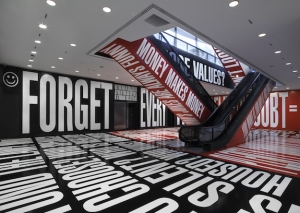
The Smithsonian's Hirshhorn Museum and Sculpture Garden commissioned internationalled renowned artist Barbara Kruger to create a site-specific installation for one of the museum's most-visited public spaces. Opening Aug. 20, "Belief+Doubt"(2012) will fill the lower-level lobby and extend into the newly relocated museum bookstore. Approximately 6,700 square feet of surface--including walls, floor and escalator sides--will be covered in text-printed vinyl, surrounding viewers with lettering up to 12 feet high in a high-contrast color scheme of red, white and black.
"Belief+Doubt" speaks to the social relations and networks of power that define daily life. At a time when the value of certitude is taken for granted, Kruger says she is "interested in introducing doubt." Large swaths of the floor are covered in open-ended questions ("WHO IS BEYOND THE LAW? WHO IS FREE TO CHOOSE? WHO SPEAKS? WHO IS SILENT?"), while the area facing the bookstore explores desire and consumption ("YOU WANT IT. YOU BUY IT. YOU FORGET IT.").
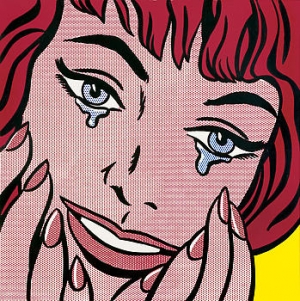
The Gagosian Gallery has announced that they will be participating in ArtRio for the first time this year. Held September 12-16, ArtRio features major works by current artists and other modern masters. Gagosian plans to not only have a booth at the fair, but will also hold a sculpture exhibition in an offsite warehouse. Both the booth and the warehouse will be designed by Brazilian designer Claudia Moreira Salles.
There has been some chatter about Gagosian expanding internationally and as Brazil's art market has expanded considerably in recent years, ArtRio seems a logical destination for Gagosian. Works by Damien Hirst, Cecily Brown, Alexander Calder, Jeff Koons, Roy Lichtenstein, Takashi Murakami, Pablo Picasso, Robert Rauschenberg, Richard Serra, Cy Twombly, Andy Warhol, and many others will be on view.
ArtRio will coincide with the first major retrospective of Alberto Giacometti in South America. The show will run through September 16th at the Museu de Arte de Moderne do Rio de Janeiro and brings together 280 works from the Fondation Alberto e Annette Giacometti in Paris, which is represented by the Gagosian Gallery.
In 1973, Robert Scull, the owner of a New York City taxi fleet, sold off the bulk of his noted Pop Art collection at Sotheby’s, in the process earning $85,000 for a painting by Robert Rauschenberg entitled Thaw that he had bought fifteen years earlier for $900 from the artist’s dealer. Rauschenberg, who had attended the sale, came up to the collector at the end, shoved him and said scornfully, “I’ve been working my ass off for you to make that profit?” Scull replied to the artist, “You’re going to sell now, too. We’ve been working for each other.” In other words, higher prices on the secondary market result in greater demand and higher prices on the primary market. However, Rauschenberg’s anger did not abate, and he became an advocate for “resale royalties,” whereby collectors pay artists (or their heirs if it’s within seventy years of the artist’s death) a percentage of the profits they earn when they sell an artwork.
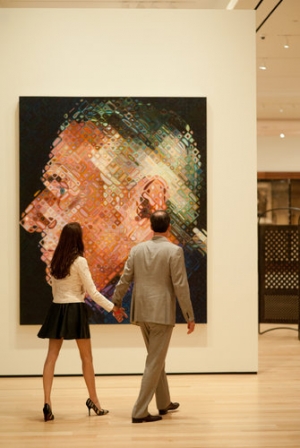
“There’s one thing I’ve heard over and over again here,” says Edward Saywell, the top contemporary art curator at the Museum of Fine Arts, Boston, who is showing off works by Ellsworth Kelly, Kara Walker, Cindy Sherman and other contemporary artists in his domain, including many new ones. “They say, ‘This can’t be Boston,’ and I say, ‘Yes, it really is.’ ”
The people in Mr. Saywell’s tale are marveling at the museum’s new Linde Family Wing for Contemporary Art, an airy 80,000 square-foot space that opened in mid-September, but they may as well be talking about the city as a whole. Boston is known for its wealth of Old Masters, Impressionist paintings and historic American art, not for works by living artists.
But mark fall 2011 as the moment that may change that reputation, and not just because of the Linde wing, whose 24-hour inaugural party managed to muster a small crowd even at 3 a.m., when tickets cost $50, compared with $200 at 7 p.m. (If they had waited until 7 a.m., tickets were free.)
Since September, the Institute of Contemporary Art has been celebrating its 75th birthday and its fifth year in new home, where attendance has shot up to 200,000 a year from 20,000 in its previous site. “Before we got the new building, Jill used to say we were striving to be marginal,” says Barbara Lee, a trustee, referring to the institute’s director, Jill Medvedow.
Now, the Institute of Contemporary Art is credited with helping to revitalize Boston’s waterfront. And under its chief curator, Helen Molesworth, who was hired last year, it is mounting more ambitious exhibitions with prestigious partners like the Tate Modern in London, an important step to gaining influence nationally and internationally.
More change is coming. In January, the Isabella Stewart Gardner Museum, a Venetian-style palazzo full of masterpieces from earlier eras, will open a glass-walled building with new gallery space for temporary exhibitions, including contemporary art.
The List Visual Arts Center at the Massachusetts Institute of Technology will soon have a new director, Paul Ha, who has been the leader of the Contemporary Art Museum in St. Louis in Missouri. There, he improved his museum’s stature and earned a reputation for giving future art stars their first major museum exhibitions.
In 2013, the Harvard Art Museums will open bigger and renovated premises with “a significantly expanded program for the exhibition, study, and interpretation of the art of our time,” says Deborah Martin Kao, its chief curator. And the Massachusetts College of Art and Design, just one of the area’s art schools with a growing student population, is in the midst of an expansion, too.
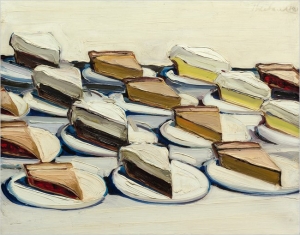
The auction of 42 works from the collection of the late New York dealer Allan Stone held at Sotheby’s on Monday evening is one of those events that announce the advent of an era. The antiquities of Contemporary art were on sale.
To drive the point home, Sotheby’s did not use the word “contemporary” on the covers of the two catalogs printed for the occasion.
On volume one, the uncharacteristically small title states merely “The Collection of Allan Stone.” An inside page proclaims in white on black (a discreet hint at Mr. Stone’s death in 2006) “Allan Stone is a Celebration of art collecting and an insight into the sophisticated eye of this renowned New York dealer.” There follows a seven-page chronology of artistic development on the New York scene from the 1940s to 2006 illustrated with pictures in the sale. If you were not absolutely dense, you knew that you were being confronted with Cultural History in capital letters.
The message got across. The attendance was galvanized.
The first lot was a small sheet of paper with additional bits of paper pasted on, and most importantly, the New York artist Franz Kline’s signature followed by a date, 1957. Kline had violently smeared the paper with black paint. Although “Untitled,” as Sotheby’s dubbed it, was only 11 by 83/8 inches, or 27.9 by 21.2 centimeters, the experts had given it a $90,000 to $120,000 estimate plus a sale charge of more than 20 percent. Dazzled, the room sent it flying to $446,500.
Another “Untitled” followed, signed by John Chamberlain in 1961. Scraps of painted steel, crushed and welded, are attached together with discarded shreds of fabric to a sturdy backing board. It made you briefly wonder whether the artist, rummaging in a scrap heap, had tried to pay homage to the victims of some ghastly car accident. Bidders responded to this monument of old Contemporary art. It doubled expectations at $662,500.
That work served as a prelude to Chamberlain’s big jumble of painted and chromium-plated steel fragments that came up moments later. Executed in 1958, it conjured far more realistically the image of a car wreck. Here, the artist had coined a title, “Nutcracker.” The Cleveland Museum of Art had included “Nutcracker” in a brief Chamberlain exhibition in January 1967. The Solomon R. Guggenheim Museum gave it the ultimate accolade, when the crushed steel jumble was featured in “John Chamberlain: A Retrospective Exhibition” in the early 1970s. After that, it was impossible to mistake “Nutcracker” for a haphazard assemblage of scrap metal. Bidders ran it up to $4.78 million.
Other hefty prices followed. Willem de Kooning’s “Event in a Barn,” done in 1947 in oil, enamel and paper collage on board, was likewise reassuringly set in the concrete of art history. It had traveled the United States in 2006 and 2007 as part of the show “Picasso and American Art.” De Kooning’s picture realized $4.56 million.
|
|
|
|
|